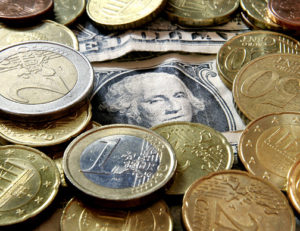 Yesterday’s trade saw EUR/USD within the range of 1.1544-1.1641. The pair closed at 1.1605, gaining 0.38% on a daily basis. On Friday the cross fell to lows unseen since November 11th 2003 at 1.1459. During the week ended on January 16th EUR/USD registered its fifth consecutive weekly loss, falling 2.31%.
Yesterday’s trade saw EUR/USD within the range of 1.1544-1.1641. The pair closed at 1.1605, gaining 0.38% on a daily basis. On Friday the cross fell to lows unseen since November 11th 2003 at 1.1459. During the week ended on January 16th EUR/USD registered its fifth consecutive weekly loss, falling 2.31%.
At 8:37 GMT today EUR/USD was down 0.16% for the day to trade at 1.1585. The pair touched a daily low at 1.1568 at 7:00 GMT.
Fundamentals
Euro zone
Italian Balance of trade
The surplus on Italys trade balance probably narrowed to EUR 4.320 billion in November, according to market expectations, from a surplus figure of EUR 5.397 billion in October. The latter was a 40% increase compared to the surplus of EUR 3.85 billion, registered in October 2013.
Total exports surged at an annualized rate of 2.9% to EUR 37.33 billion in October, supported by higher sales of capital goods (+ 3.7%) and sales of consumer goods (+ 3.3%). Exports to the European Union increased 4.7%, as Belgium (+ 14.4%), Czech Republic (+ 9.4%) and Poland (+ 8.8%) were the most dynamic markets for shipments. At the same time, total imports dropped 1.6% in October to EUR 31.94 billion. Purchases of capital goods rose 4.1%, while those of consumer goods were up 2.6%. Energy imports were 18.3% lower during the same period.
The trade balance, as an indicator, measures the difference in value between the country’s exported and imported goods during the reported period. It reflects the net export of goods, or one of the components to form the Gross Domestic Product. Generally, exports reflect how strong economic growth is, while imports indicate the strength of domestic demand. In case Italian trade surplus narrowed more than anticipated, this might have a certain bearish effect on the single currency. The National Institute of Statistics (Istat) is to release the official trade data at 9:00 GMT.
German, Euro zone Economic Sentiment Index
The gauge of economic sentiment in Germany probably improved to 40.0 in January, according to the median forecast by experts, from 34.9 in December. If so, this would be the highest index reading since April 2014, when it was reported at 43.2. In October last year the index entered into negative territory for the first time since November 2012, slipping to -3.6.
The ZEW (Zentrum für Europäische Wirtschaftsforschung) economic expectations index is published monthly. The study encompasses up to 350 financial and economic analysts. The indicator reflects the difference between the share of analysts, that are optimistic and those, that are pessimistic about the expected economic development in Germany over the next six months. A positive value indicates that the proportion of optimists is larger than that of pessimists. A ZEW reading of -100 suggests that all analysts are pessimistic about the current developments and expect economic conditions to deteriorate. A ZEW reading of 100 implies that all analysts are optimistic about the current situation and expect conditions to improve. A ZEW reading of 0 indicates neutrality.
The index of current assessment in Germany probably rose to a value of 13.0 in January from 10.0 in the prior month. If so, this would be the highest level since September 2014, when a value of 25.4 was reported.
The ZEW Economic Sentiment index for the whole Euro zone probably gained ground in January, reaching 14.9. If so, this would be the highest level since August 2014, when the indicator came in at 23.7. In December the index stood at 10.0.
In case the gauge of economic sentiment exceeded expectations, this would certainly have a positive impact on the common currency. The official data is scheduled to be released at 10:00 GMT.
Stimulus package
The European Central Bank will probably announce a 550 billion-euro bond-purchasing program on January 22nd, according to 93% of respondents in a Bloomberg survey of economists, which exceeds the 500-billion-euro models, presented to ECB officials earlier in the month.
United States
NAHB Housing Market Index
The National Association of Home Builders (NAHB) Housing Market Index probably continued to rise in January, reaching 58.0, according to expectations, from 57.0 in December. If so, this would be the highest index reading since September, when the indicator stood at 59.0. It is based on a monthly survey in regard to current home sales and expected sales in the coming six months. Values above the key level of 50.0 indicate that housing market conditions are good. Therefore, higher-than-projected readings would provide support to the greenback. The official data is scheduled for release at 15:00 GMT.
Pivot Points
According to Binary Tribune’s daily analysis, the central pivot point for the pair is at 1.1597. In case EUR/USD manages to breach the first resistance level at 1.1649, it will probably continue up to test 1.1694. In case the second key resistance is broken, the pair will probably attempt to advance to 1.1746.
If EUR/USD manages to breach the first key support at 1.1552, it will probably continue to slide and test 1.1500. With this second key support broken, the movement to the downside will probably continue to 1.1455.
The mid-Pivot levels for today are as follows: M1 – 1.1478, M2 – 1.1526, M3 – 1.1575, M4 – 1.1623, M5 – 1.1672, M6 – 1.1720.
In weekly terms, the central pivot point is at 1.1633. The three key resistance levels are as follows: R1 – 1.1808, R2 – 1.2046, R3 – 1.2221. The three key support levels are: S1 – 1.1395, S2 – 1.1220, S3 – 1.0982.





